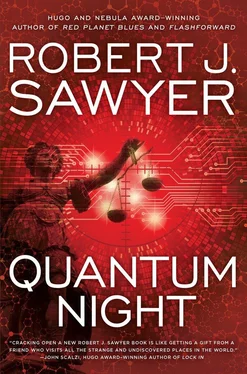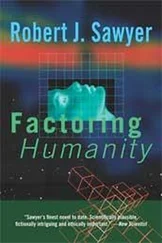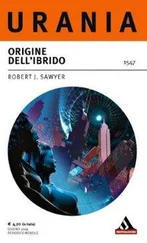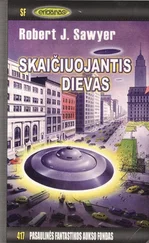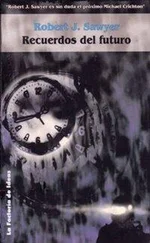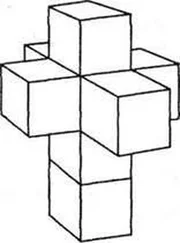Quantum Night
by Robert J. Sawyer
It may be a requirement for a theory of consciousness that it contains at least one crazy idea.
—David Chalmers
For
Chase Masterson
Beautiful inside and out
Several of my colleagues in the University of Manitoba’s psychology department considered teaching to be a nuisance—“the ineluctable evil,” as Menno Warkentin used to call it, resenting the time it took away from his research—but I loved it. Oh, maybe not as much as I loved bananas, or binge-watching old episodes of Curb Your Enthusiasm or Arrested Development, or photographing globular clusters with my telescope, but as far as things that people would actually pay me to do are concerned, it was right up there.
Granted, teaching first-year classes could be overwhelming: vast halls filled with stagnant air and row after row of angst-soaked teenagers. Although my own freshman year had been two decades ago, I vividly remembered signing up to take introductory psych in hopes of making sense of the bewildering mélange of anxiety and longing that swirled then—and pretty much now, too—within me. Cogito ergo sum? More like sollicito ergo sum—I fret, therefore I am.
But on this gray morning, I was teaching The Neuroscience of Morality, a third-year class with fewer students than February had days—and that allowed for not just lecturing but dialog.
Last session, we’d had a spirited discussion about Watson and Skinner, focusing on their notion that humans were nothing more than stimulus-response machines whose black-box brains simply spit out predictable reactions to inputs. But today, instead of continuing to demolish behaviorism, I felt compelled to take a dark detour, using the ceiling-mounted projector to show the Savannah Prison photos WikiLeaks had made public over the weekend.
Some were individual frames from security-camera video, the guards caught unawares from on high. Although what those depicted was brutal, they weren’t the most disturbing images. No, the really disquieting ones—the ones that knotted your stomach, that made you avert your eyes, that you just couldn’t fucking believe—were the posed photos: the picture of the officer with her boot on a prisoner’s back while she gave a jaunty thumbs-up to whatever asshole was holding the iPhone; the still of the two uniformed men tossing a naked, emaciated prisoner so hard against the ceiling that his skull, as x-rays would later show, had fractured in three places; the snapshot of the mustachioed sergeant straddling a downed man while defecating on his chest, one hand clamped over the inmate’s mouth, the other flashing a peace sign, the image then having been run through Instagram to make it look like an old-fashioned Polaroid, white frame and all.
My stomach roiled as I stepped through the slides, one atrocity giving way to the next. It was now sixteen years after Abu Ghraib, for God’s sake, and a half century since Philip Zimbardo’s Stanford Prison experiment. Not only were guards supposed to be trained about situational pressures and how to avoid succumbing to them, but two of those shown in the photos were studying to be wardens. They knew about Zimbardo; they were aware of Stanley Milgram’s shock-machine obedience-to-authority experiments; they’d read summaries of the Taguba Report on the Abu Ghraib atrocities.
And yet, despite being specifically taught to recognize and avoid the pitfalls—a word that at first seemed innocuous but, if one reflected upon it, suggested tumbling into the abyss, following Lucifer into the very fires of hell—each of these men and women had dehumanized the perceived enemy, and, in the process, had lost their own humanity.
“All right,” I said to the shocked faces of my students. “What can we take from all this? Anyone?”
The first hand that went up belonged to Ashton, who still had acne and hadn’t yet learned that it was permissible to trim a beard. I pointed at him. “Yes?”
He spread his arms as if the truth were self-evident. “Simple,” he said, and he flicked his head toward the screen behind me, which I’d left on the last slide, the one showing a gangly guard named Devin Becker killing a naked prisoner by holding his head under water in a jail-cell sink. “You can’t change human nature.”
The call had come just about a year ago. “Hello?” I’d said into the black handset of my office phone.
“Professor James Marchuk?”
I swung my feet up on my reddish-brown desk and leaned back. “Speaking.”
“My name is Juan Garcia. I’m part of the defense team for Devin Becker, one of the Savannah Prison guards.”
I thought about saying, “Well, you’ve got your work cut out for you,” but instead simply prodded him to go on. “Yes?”
“My firm would like to engage you as an expert witness in Mr. Becker’s trial. The prosecution is seeking the death penalty. We’re likely to lose on the facts—the security-camera video is damning as hell—but we can at least keep Becker from being executed if we get the jury to agree that he couldn’t help himself.”
I frowned. “And you think he couldn’t because…?”
“Because he’s a psychopath. You said it in your blog entry on Leopold and Loeb: you can’t execute someone for being who they are.”
I nodded although Garcia couldn’t see it. In 1924, two wealthy university students, Nathan Leopold and Richard Loeb, had killed a boy just for kicks. Leopold considered himself and Loeb to be exemplars of Nietzsche’s Übermenschen and thus exempt from laws governing ordinary men. Supermen they weren’t, but psychopaths they surely were. Their parents engaged none other than Clarence Darrow to represent them. In a stunning twelve-hour-long closing argument, Darrow made the same defense Garcia was apparently now contemplating: claiming Becker couldn’t be executed for doing what his nature dictated he do.
I took my feet off the desk and leaned forward. “And is Becker a psychopath?” I asked.
“That’s the problem, Professor Marchuk,” said Garcia. “The D.A. had a Hare assessment done, which scored Becker at seventeen—way below what’s required for psychopathy. But we think their assessor is wrong; our guy squeaks him into psychopathy with a score of thirty-one. And, well, with your new procedure, we can prove to the jury that our score is the right one.”
“You know my test has never been accepted in a court of law?”
“I’m aware of that, Professor. I’m also aware that no one has even tried to introduce it into evidence yet. But I’ve got your paper in Nature Neuroscience right here. That it was published in such a prestigious, peer-reviewed journal gets our foot in the door; Georgia follows the Daubert standard for admissibility. But we need you—you personally, the lead author on the paper—to use your technique on Becker and testify about the results if we’ve got any chance of having the court accept the evidence.”
“What if I show that Becker isn’t a psychopath?”
“Then we’ll still pay you for your time.”
“And bury the results?”
“Professor, we’re confident of the outcome.”
It sounded worthwhile—but so was what I did here. “I have a busy teaching schedule, and—”
“I know you do, Professor. In fact, I’m looking at it right now on your university’s website. But the trial probably won’t come up until you’re on summer break, and, frankly, this is a chance to make a difference. I’ve read your Reasonably Moral blog. You’re against the death penalty; well, here’s a chance to help prevent someone from being executed.”
Читать дальше
